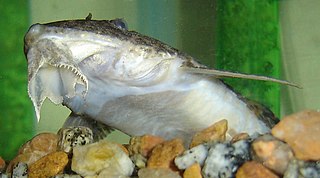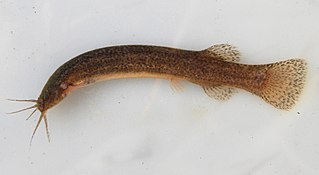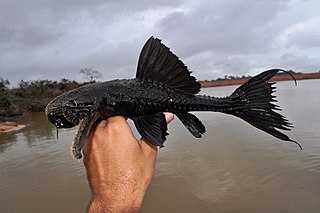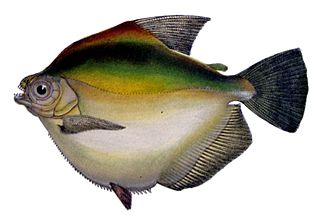
Loricariidae is the largest family of catfish, with 92 genera and just over 680 species. Loricariids originate from freshwater habitats of Costa Rica, Panama, and tropical and subtropical South America. These fish are noted for the bony plates covering their bodies and their suckermouths. Several genera are sold as "plecos", notably the suckermouth catfish, Hypostomus plecostomus, and are popular as aquarium fish.

Hypostomus is a genus of catfish in the family Loricariidae. They are native to tropical and subtropical South America. H. plecostomus is the popular freshwater aquarium fish formerly known as Plecostomus plecostomus. There is a lot of confusion as to the precise taxonomic structure of the Loricariidae.

Rineloricaria is a genus of freshwater tropical catfish belonging to the family Loricariidae. They are commonly called whiptail catfish because of the long filament that grows out of the tip of the caudal fin that is characteristic of the genus. With the exception of R. altipinnis from Panama, they are native to the rivers of northern and central South America. Some species are regularly seen in the aquarium trade.

Hemiancistrus is a genus of suckermouth armored catfishes. These species are native to South America. The taxonomy of this genus is complex and unclear, and major work has to be done. Many of these fish are popular aquarium fish.
Spectracanthicus is a genus of suckermouth armored catfish endemic to the Tapajós, Xingu and Tocantins river basins in Brazil where often found in fast-flowing waters. The largest species in the genus reaches up to 13 cm (5.1 in) in standard length. They feed on algae and small invertebrates.

The Hypoptopomatinae are a subfamily of catfishes of the family Loricariidae, composed of 17 genera and approximately 80 species. This subfamily represents about one-tenth of all loricariid species.
Neoplecostominae is a subfamily of South American catfishes of the family Loricariidae. Species of this subfamily live in high-mountain and swift-flowing river habitats.

Parotocinclus is a genus of fish in the family Loricariidae native to South America. This genus is distributed through almost all hydrographic systems in South America from the Guyana Shield drainages and Amazon Shield tributaries to the coastal drainages of eastern and southeastern Brazil, including the rio São Francisco basin. Most species have the caudal peduncle oval in cross section. It has been found that Characidium species may interact with P. maculicauda. The small Characidium will follow grazing P. maculicauda, which release particulate matter dislodged from the catfish's foraging.
Pareiorhina is a genus of armored catfishes native to South America where they are only found in Brazil. These species are known to occur at altitudes above 650 metres (2100 ft) in various rivers of the Grande, Paraíba do Sul, São Francisco and Tietê River basins. This genus was first erected by Gosline in 1947 as a monotypic genus to include Rhinelepis rudolphi. It was not until 2003 that a second species, P. carrancas, was described. The third species, P. brachyrhyncha was described in 2005. Pareiorhina forms a monophyletic subunit with Neoplecostomus within the subfamily Neoplecostominae.

Pseudacanthicus is a genus of medium to large-sized suckermouth armored catfishes native to South America, where found in the Amazon and Orinoco basins, as well as rivers of the Guianas. They are primarily found in fast-flowing waters, sometimes relatively deep. They are sometimes kept in aquariums.

Ituglanis is a genus of small freshwater fish in the family Trichomycteridae native to South America. Their greatest diversity seems to occur in the Amazon River basin. Most species inhabit leaf litter, with several species living in caves.
Gymnotocinclus is a genus of small freshwater catfish in the family Loricariidae, native to the Tocantins River basin in Brazil.

Acanthicus adonis, the adonis pleco or polka dot lyre-tail pleco, is a large species of armored catfish. It was originally described from the lower Tocantins River in Brazil, but individuals resembling the species have also been recorded from Amazonian Peru. The species is occasionally seen in the aquarium trade, but its massive adult size and territorially aggressive behavior means that a very large tank is required. These fish are opportunistic omnivores.

Acanthicus hystrix, the lyre-tail pleco, is a species of armored catfish native to the Amazon, Tocantins–Araguaia and Orinoco basins. It is typically found at various depths on a rock or rock–gravel bottom in the main channel of rivers in places with moderate to strong current, although it also occurs in slow currents. The species is occasionally seen in the aquarium trade, but its adult size and territorially aggressive behavior means that a very large tank is required.
Rhinolekos is a genus of armored catfishes native to South America. This genus is only known from the Tocantizinho River and Paranaiba River drainage in Goiás, Brazil.

Mylossoma duriventre, the silver mylossoma, is a species of freshwater serrasalmid fish endemic to tropical and subtropical South America. It grows to a maximum length of about 25 cm (10 in) and a weight of 1 kg (2.2 lb). It is the subject of a local fishery, being known as pacu in Brazil and palometa in Venezuela.
Corumbataia liliai is a species of armored catfish endemic to Brazil, where it is found in the Upper Rio Paraná basin, Goiás, Brazil. This species grows to a length of 3 centimetres (1.2 in) SL.
Corumbataia lucianoi is a species of armored catfish endemic to Brazil, where it is found in the Upper Rio Paraná basin, Goiás, Brazil. This species grows to a length of 3 centimetres (1.2 in) SL.
Pseudacanthicus pirarara is a species of catfish in the family Loricariidae native to South America. It was described in 2016 by Carine C. Chamon of the Federal University of Tocantins and Leandro M. de Sousa of the Federal University of Pará, primarily on the basis of the species' unique coloration and patterning. Its specific epithet, pirarara, derives from a Tupi word meaning "macaw-fish", which is frequently used in Brazil to refer to the redtail catfish. It is known that P. pirarara is referred to as the assacu-pirarara by Brazilian fishermen, alluding both to its coloration and its spines, as assacu refers to the spine-covered tree Hura crepitans.
Pseudacanthicus pitanga is a species of catfish in the family Loricariidae. It is native to South America, where it occurs in the Tocantins River basin in Brazil. The species reaches 30 cm SL. It was described in 2015 by Carine C. Chamon of the Federal University of Tocantins on the basis of distinctive coloration and morphology. Its specific epithet, pitanga, is derived from a Tupi-Guarani word meaning "red", in reference to the color of the species' fins.










